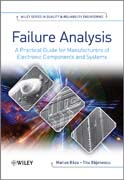
Failure analysis: a practical guide for manufacturers of electronic components and systems
Bazu, Marius
Bajenescu, Titu
Failure analysis is the preferred method to investigate product or process reliability and to ensure optimum performance of electrical components and systems. The physics-of-failure approach is the only internationally accepted solution for continuously improving the reliability of materials, devices and processes. The models have been developed from the physical and chemical phenomena that are responsible for degradation or failure of electronic components and materials and now replace popular distribution models for failure mechanisms such as Weibull or lognormal. Reliability engineers need practical orientation around the complex procedures involved in failure analysis. This guide acts as a tool for all advanced techniques, their benefits and vital aspects of their use in a reliability programme. Using twelve complex case studies, the authorsexplain why failure analysis should be used with electronic components, when implementation is appropriate and methods for its successful use. Inside you will find detailed coverage on: a synergistic approach to failure modes and mechanisms, along with reliability physics and the failure analysis of materials,emphasizing the vital importance of cooperation between a product developmentteam involved the reasons why failure analysis is an important tool for improving yield and reliability by corrective actions the design stage, highlighting the concurrent engineering' approach and DfR (Design for Reliability) failure analysis during fabrication, covering reliability monitoring, process monitors and package reliability reliability resting after fabrication, including reliability assessment at this stage and corrective actions a large variety of methods, such as electrical methods, thermal methods, optical methods, electron microscopy, mechanical methods, X-Ray methods, spectroscopic, acoustical, and laser methods new challenges in reliability testing, such as its use in microsystems and nanostructures This practical yet comprehensive reference is useful for manufacturers and engineers involved in the design, fabrication and testing of electronic components, devices, ICs and electronic systems, as well as for users of components in complex systems wanting to discover the roots ofthe reliability flaws for their products. INDICE: About the Authors. Preface. 1. Introduction. 1.1. The three goals of the book. 1.2. Historical perspective 1.3. Terminology. 1.4. State of the art and future trends. 1.5. General plan of the book. References. 2. Failure analysis - Why? 2.1. Eight possible applications. 2.2. Forensic engineering. 2.3. Reliability modeling. 2.4. Reverse engineering. 2.5. Controlling critical input variables. 2.6. Design for Reliability. 2.7. Process improvement. 2.8. Saving money by early control. 2.9. A synergetic approach. References. 3. Failureanalysis - When? 3.1. During development cycle. 3.2. Preparing the fabrication. 3.3. During fabrication. 3.4. After fabrication. 3.5. During operation or storage. References. 4. Failure analysis - How? 4.1. Procedures for failure analysis. 4.2. Techniques for decapsulating the device and for sample preparation. 4.3. Techniques for failure analysis. References. 5. Failure Analysis - What? 5.1 Failure modes and mechanisms at various process steps. 5.2 Failure modesand mechanisms of passive electronic parts. 5.3 Failure modes and mechanisms of silicon bipolar technology. 5.4 Failure modes and mechanisms of MOS technology. 5.5 Failure modes and mechanisms of optoelectronic and photonic technologies. 5.6 Failure modes and mechanisms of non-silicon technologies. 5.7 Failuremodes and mechanisms of hybrid technology. 5.8 Failure modes and mechanisms of microsystem technologies. References. 6. Case studies. 6.1 Case study no. 1:Capacitors. 6.2 Case study no. 2: Bipolar power devices. 6.3 Case study no. 3: CMOS devices. 6.4 Case study no. 4: MOS field effect transistors. 6.5 Case study no. 5: Thin film transistors. 6.6 Case study no. 6: High electron mobility transistors. 6.7 Case study no. 7: MEMS resonators. 6.8 Case study no. 8: MEMS micro-cantilevers. 6.9 Case study no. 9: MEMS switches. 6.10 Case study no.10: Magnetic MEMS switches. 6.11 Case study no. 11: Chip scale packages. 6.12Case study no. 12: Solder joints. 6.13 Conclusions. References 7. Conclusions. Acronyms. Glossary. Index.
- ISBN: 978-0-470-74824-4
- Editorial: John Wiley & Sons
- Encuadernacion: Cartoné
- Páginas: 344
- Fecha Publicación: 08/04/2011
- Nº Volúmenes: 1
- Idioma: Inglés
